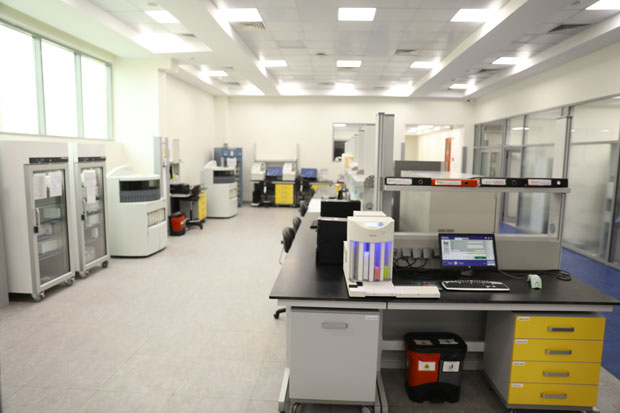ETV6-NTRK3 Rearrangement

- Clinical Implications
- Diagnosis of Infantile fibrosarcoma
- Diagnosis of Congenital mesoblastic nephroma
- Classic (24%): Has no genetic abnormality.
- Cellular (66%): t(12;15)(p13;q25) translocation resulting in ETV6-NTRK3 fusion.
- Diagnosis of Secretory carcinoma
- Other tumors
- ALK-negative inflammatory myofibroblastic tumor, some GISTs, and some radiation-induced papillary thyroid carcinoma and acute myeloid leukemia.
- Characteristic t(12;15)(p13;q25) with ETV6-NTRK3 fusion
- Test Description
- Test approach
- Reporting name
- Test prerequisites (To ensure timely results)
- Patient’s demographic data.
- Clinicopathologic information:
- Pathology report (final or preliminary) including anatomic location.
- History of any given therapy for cancer and its date and relation to sample sent for molecular study (i.e. pre & post therapy). Therapy includes chemo and radiotherapy, hormonal or targeted therapy.
- Any other relevant clinical data or history.
- Type of sample:
- Preferred: Formalin-fixed, paraffin-embedded (FFPE) tumor tissue block.
- Acceptable:
- Section in Eppendorf: Up to 4 sections, each with a thickness of up to 10 μm and a surface area of up to 250 mm2 + good H&E slide for assessment.
- Five unstained slides + one good H&E slide.
- Specimen Minimum Volume: Two 10-micron sections of FFPE.
- Quality Control measures
- From your side:
- Double check you are fulfilling all required data before sending your sample.
- Check that your pathologist has selected the best block in terms of tumor cellularity, with least presence of necrosis and inflammation.
- Pretherapy sample is preferred (if underwent any cancer therapy).
- In our lab:
- Assessment of tissue for adequacy & tumor cellularity before any molecular analysis.
- Matching block ID with the report ID and demographic data.
- Matching the submitted block with the data reported in the pathology report.
- N.B.
- If the sample sent in Eppendorf, it is your pathology lab’s responsibility to ensure the sample in Eppendorf is corresponding to the submitted H&E slide (we can’t prepare slide from Eppendorf).
- This test does not include a pathology consultation.
- Test Time
- Retention of the sample
- Selected References
- Sheng WQ et al: Congenital-infantile fibrosarcoma. A clinicopathologic study of 10 cases and molecular detection of the ETV6-NTRK3 fusion transcripts using paraffin-embedded tissues. Am J Clin Pathol. 115(3):348-55, 2001
- Argani P et al: Detection of the ETV6-NTRK3 chimeric RNA of infantile fibrosarcoma/cellular congenital mesoblastic nephroma in paraffin-embedded tissue: application to challenging pediatric renal stromal tumors. Mod Pathol. 13(1):29-36, 2000
- Bourgeois JM et al: Molecular detection of the ETV6-NTRK3 gene fusion differentiates congenital fibrosarcoma from other childhood spindle cell tumors. Am J Surg Pathol. 24(7):937-46, 2000
- Knezevich SR et al: A novel ETV6-NTRK3 gene fusion in congenital fibrosarcoma. Nat Genet. 18(2):184-7, 1998
- Knezevich SR et al: ETV6-NTRK3 gene fusions and trisomy 11 establish a histogenetic link between mesoblastic nephroma and congenital fibrosarcoma. Cancer Res. 58(22):5046-8, 1998
- Rubin BP et al: Congenital mesoblastic nephroma t(12;15) is associated with ETV6-NTRK3 gene fusion: cytogenetic and molecular relationship to congenital (infantile) fibrosarcoma. Am J Pathol. 153(5):1451-8, 1998
- Laé M et al: Secretory breast carcinomas with ETV6-NTRK3 fusion gene belong to the basal-like carcinoma spectrum. Mod Pathol. 22(2):291-8, 2009
- Arce C et al: Secretory carcinoma of the breast containing the ETV6-NTRK3 fusion gene in a male: case report and review of the literature. World J Surg Oncol. 3:35, 2005
- Skálová A et al: Mammary analogue secretory carcinoma of salivary glands, containing the ETV6-NTRK3 fusion gene: a hitherto undescribed salivary gland tumor entity. Am J Surg Pathol. 34(5):599-608, 2010
Infantile fibrosarcoma: Infiltrative, rarely metastasizing fibroblastic sarcoma of infancy associated with ETV6-NTRK3 gene fusion.
Congenital mesoblastic nephroma: Spindle cell neoplasm of kidney.
Subtypes/variants:
Mammary analogue secretory carcinoma: Salivary gland tumor characterized by ETV6 translocations, identical to secretory carcinoma of breast.
Real-time PCR for quantitative detection of ETV6-NTRK3 gene rearrangement
RNA was isolated and converted into cDNA. TaqMan Gene Expression Assay was used for quantitative polymerase chain reaction (qPCR) analysis of ETV6-NTRK3 fusion transcript. Results interpreted according to the manufacture user guide.
ETV6-NTRK3 Gene fusion PCR
All samples are subject to stringent quality control measures that include:
From 3 days to 5 working days.
Client provided paraffin blocks & unstained slides (if provided) will be returned after testing is complete.